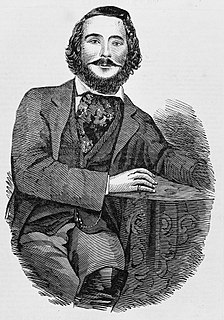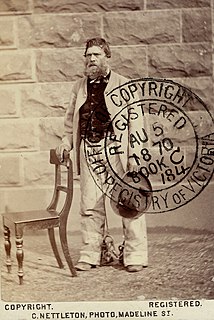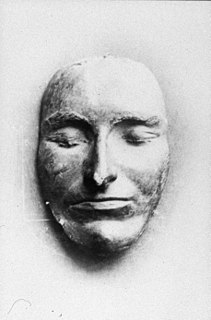Daniel Priest (1814–1883) was a convict and bushranger in nineteenth century Tasmania. Priest escaped from the penal settlement at Port Arthur and became a bushranger while trying to avoid arrest.

Bushrangers were originally escaped convicts in the early years of the British settlement of Australia who used the Australian bush as a refuge to hide from the authorities. By the 1820s, the term "bushranger" had evolved to refer to those who took up "robbery under arms" as a way of life, using the bush as their base.

Tasmania is an island state of Australia. It is located 240 km (150 mi) to the south of the Australian mainland, separated by Bass Strait. The state encompasses the main island of Tasmania, the 26th-largest island in the world, and the surrounding 334 islands. The state has a population of around 526,700 as of March 2018. Just over forty percent of the population resides in the Greater Hobart precinct, which forms the metropolitan area of the state capital and largest city, Hobart.

Port Arthur is a small town and former convict settlement on the Tasman Peninsula, in Tasmania, Australia. Port Arthur is one of Australia's most significant heritage areas and an open-air museum.
He became known to those he robbed as 'the friendly bushranger' on account of his 'almost unparalleled mildness and kindness towards persons with whom he came into collision in pursuit of his lawless career.' [1] Priest held up settlers at gunpoint but only took what he needed and was never violent.
In 1845, he was eventually caught and, at an appearance before the Police Magistrate, witness George Lucas, who had recently been robbed, claimed the coat and trousers worn by Priest, were his. Priest replied: 'Yes, you're right, they're yours; you have told a very correct yarn ; all that you have said is very true.' [2] When the Magistrate then told Priest that they would have to find him some other clothes, Priest answered, 'Just as you please, Sir, it's not as I like now.' [2]
Priest was sentenced to hang, but after the intervention of many members of the public, including three priests and several people who he had robbed, his sentence was commuted to ten years at Norfolk Island. [3] [4] [5]

Norfolk Island is a small island in the Pacific Ocean located between Australia, New Zealand, and New Caledonia, 1,412 kilometres (877 mi) directly east of mainland Australia's Evans Head, and about 900 kilometres (560 mi) from Lord Howe Island. Together with the two neighbouring islands Phillip Island and Nepean Island it forms one of the Commonwealth of Australia's external territories. At the 2016 Australian census, it had 1748 inhabitants living on a total area of about 35 km2 (14 sq mi). Its capital is Kingston.









